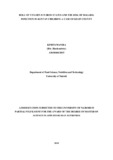| dc.description.abstract | Introduction: In Kilifi County, malaria infection is a major cause of mortality with children under the age of five years being the most vulnerable. Iron status influences susceptibility to malaria while Vitamin D status may also have an important influence to susceptibility and severity. Despite this, there is insufficient information on the vitamin D status of children in the coastal region where malaria infections are highly prevalent. The general objective of this study, therefore, was to find out the association between vitamin D status and iron status and how this interaction alters the risk of malaria infection in Kenyan children.
Research Methods: A cross sectional study was carried out in 1487 children in Kilifi County, Junju and Ngerenya areas. Longitudinal data on anthropometry, haemoglobin, auxiliary temperature and a malaria blood slide. Laboratory analysis was carried out for ferritin, C-reactive protein, transferrin, hepcidin and soluble transferrin receptor. Data was analysed for descriptive and inferential statistics.
Results: The overall geometric mean serum 25-hydroxycholecalciferol, 25OHD, was 81.9 nmol/L, (range 16, 215.5 nmol/L). The overall prevalence of vitamin D deficiency (25OHD <50nmol/L) was 6%, vitamin D insufficiency (25OHD >50 and ≤75nmol/L) was 34.1% and vitamin D sufficiency (25OHD <75nmol/L was 59.9%). An increase in vitamin D increased the risk of iron deficiency (OR 2.89, 95% CI; 2.02, 4.13; P=0.0005) and iron deficiency anaemia (OR, 5.70; 95%CI, 3.37, 9.64; P=0.0005) significantly in a univariate logistics model, but when adjusted for gender, study setting and age, the significance was lost. Low vitamin D levels (25OHD <75nmol/l) increased the risk of malaria incidence OR 2.52; 95% CI, 1.47; P=0.001, but when adjusted for age, gender and study setting, the effect was lost OR 1.31; 95% CI, 0.73, 2.37, P=0.36.
Vitamin D status was not associated with malaria parasitaemia. Moreover, vitamin D status had no influence on susceptibility to malaria infection.
Conclusion: This study led to the conclusion that; the prevalence of vitamin D insufficiency in children in Kilifi County is high, that low levels of vitamin D among healthy children is not associated with iron status nor does vitamin D status predict the risk of malaria infection.
Recommendations: Low vitamin D status is a public health concern among children in Kilifi County and these children should be targeted for supplementation programmes. Additionally, there should be increased sensitization by community health workers among caregivers on the health benefits of exposing children to sunshine as a source of vitamin D. | en_US |

